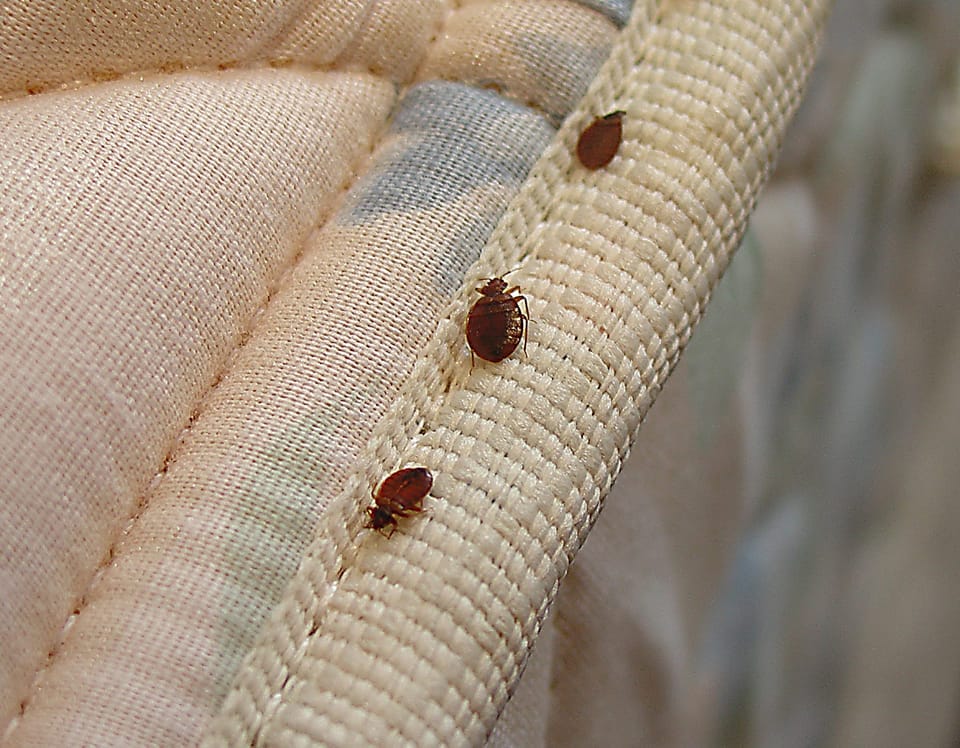Your bed is meant to be a safe space for you to retreat to relax and recharge. Therefore, being woken up by an irresistible urge to scratch yourself by tiny, bloodthirsty creatures feasting on you is a chilling scenario.
However, this is an experience millions of people worldwide, perhaps including you, have faced due to the relentless infestation of bed bugs. These elusive pests are masters of stealth, making them a formidable foe should they infest your home.
But fear not; this guide has the knowledge and strategies you need to evict these nocturnal intruders. Take these steps to kill the bed bugs in your home.
How To Get Rid Of Bed Bugs
Step 1: Identify the Problem
So, you suspect you have bedbugs at home. However, the only way to confirm a bug infestation is to find and identify them visually. But how do you differentiate bed bugs from other insects?
Fully grown bed bugs are roughly 5-7 mm long, possess a flat, oval shape, and display a reddish-brown hue. After consuming blood, bed bugs appear redder, while unfed ones are brown.
Bed bug eggs are pearl-white and about 1 mm. In contrast, nymphs (young bed bugs) are smaller versions of adults but are translucent and lighter in color.
Also, while growing, bed bugs shed their exoskeletons. Therefore, finding these skins can be a sign of infestation.
Knowing what bed bugs look like, start by thoroughly examining your living space, beginning with your bed. Remove all bedding, which includes pillowcases, blankets, and sheets. Examine the seams, crevices, and folds of the mattress and box spring.
Moreover, examine your pillows, cushions, and other upholstered furniture. Pay close attention to seams, folds, and cracks or crevices in wooden or upholstered pieces.
Also, inspect cracks and crevices along the walls, baseboards, and floorboards because bed bugs like to hide there.
Furthermore, check nearby items like nightstands, picture frames, and clutter near the bed.
Related Posts:
- How To Avoid Bed Bugs When Traveling
- 10 Common Bugs That Look Like Bed Bugs (With Pictures)
- What Do Bed Bug Eggs Look Like?
Step 2: Isolation
Keep apart the infested objects to avoid further spreading and boost the chances of success. Remove all infested bedding, including sheets, pillowcases, and blankets, place them in plastic bags, seal them tightly, and label them as “infested.”
Also, seal all the other infested items in plastic bags or containers. Also, consider encasing your mattress and box spring with bed bug-proof covers to confine any lingering bugs and deter fresh infestations.
After sealing infested items, keep them isolated, so do not remove them from the room or open the bags/containers inside your home.
If you’ve recently traveled, be sure to isolate your luggage and then look for bed bugs signs since these insects can hide there. Moreover, seal infested clothing, bedding, or curtains in plastic bags until you can launder and dry on high heat.
Step 3: De-Clutter
Clutter provides hiding spots for these pests, making it harder to locate and treat them effectively, so de-clutter your home. Place any items you wish to keep but don’t need to access immediately inside sealed plastic bags or containers.
Dispose of or consider donating the items you no longer require. However, before de-cluttering, vacuum and clean the room, paying attention to cracks, crevices, and baseboards where bed bugs may hide. Seal the canister or vacuum bag contents in an airtight plastic bag, then discard it outdoors.
Step 4: Wash and Dry
Collect all the bedding, any infested clothing, or those in close contact with your bedding. Separate infested items from non-infested ones, then wash them separately in hot water.
Maintain a water temperature of 120°F (49°C) or higher, as bed bugs and their eggs are unable to survive at these temperatures.
Use laundry detergent in your wash cycle to help dislodge and remove bed bugs and their eggs. After washing, set your dryer to its highest heat setting, then dry the clothes for 30 minutes or longer to kill any remaining bed bugs and eggs.
Once your items are clean and dry, store them in containers or plastic bags to avoid re-infestation.
Step 5: Use Non-Chemical Methods to Kill Bed Bugs
Before using chemicals to kill bed bugs, consider non-chemical alternatives as they are effective and environmentally friendly.
a) Steam Cleaning
You’ll need a steam cleaner made for household use. Look for one that can produce steam at a temperature of at least 160°F (71°C) or higher, as this is required to effectively kill bed bugs and their eggs.
Before steam cleaning, remove clutter from the area you’ll be treating and vacuum these areas to remove loose bed bugs, eggs, and debris.
After that, carefully go over the areas where bed bugs are known to hide with a steam cleaner. This includes cracks, seams, folds, and crevices in box springs, furniture, baseboards, and mattresses.
Move the steam cleaner slowly, allowing the steam to penetrate the surfaces for several seconds since bed bugs can withstand brief exposure to high temperatures.
b) Freezing
Freeze smaller infested items, such as toys or clothing, by placing them in the freezer for several days to kill bed bugs and even their eggs.
c) Vacuuming
Regularly vacuum your home, focusing on areas where bed bugs are likely to hide, such as seams, cracks, and crevices. Seal and discard the vacuum bag or contents outdoors.
d) DIY Traps and Monitors
Use DIY bed bug traps or monitors to identify and track bed bug activity. You can make double-sided tape traps, homemade bed bug interceptor traps, dry ice traps, or DIY bed bug detectors.
Combine these DIY traps and monitors with regular inspections and other non-chemical methods, such as vacuuming, washing, and de-cluttering, to manage and eliminate a bed bug infestation effectively.
e) Desiccants
Apply desiccants in infested areas to destroy bed bug coating and, in turn, dehydrate and kill them. Popular and effective desiccants are diatomaceous earth and silica aerogel.
f) Botanical insecticide spray
Botanical insecticide sprays refer to natural pest control products derived from plants, typically containing active ingredients from botanical sources like neem oil, pyrethrin, and diatomaceous earth. They are effective in killing bed bugs.
Step 6: Chemical Methods
Chemicals are useful when dealing with severe infestations or if non-chemical approaches fail. However, use these chemical treatments carefully and adhere to the safety guidelines for safety. Kill bed bugs with the following chemical methods:
a) Insecticides
You can find insecticides explicitly designed for bed bug control in various forms, including sprays, dusts, and liquids. These products typically contain chemicals that paralyze and kills bed bug by interfering with their nervous system.
Apply bed bug insecticides to cracks, crevices, and other hiding places.
b) Pyrethroids
Pyrethroids, a class of synthetic insecticides often used for bed bug control, can effectively kill bed bugs. However, some populations have developed resistance to them. Therefore, be aware of potential resistance issues in your area when using pyrethroids.
c) Neonicotinoids
Another class of synthetic insecticides you can use against bed bugs is neonicotinoids. Like insecticides, they attack the nervous system.
d) Growth Regulators
Insect growth regulators (IGRs) disrupt the reproduction of bed bugs and their development. IGRs can be particularly effective if you use them alongside other insecticides to prevent the growth and development of juvenile bed bugs.
e) Fumigation
Fumigation is a professional pest control method that involves using gas-based pesticides to treat an entire structure. Fumigation should only be performed by licensed pest control experts and is typically used for severe infestations.
Step 7: Prevent Re-infestation
After successfully eliminating bed bugs, take preventive measures to avoid future infestations. Be cautious when traveling, inspect used furniture before bringing it into your home, and maintain a clean and clutter-free living space.
In addition, cover your box spring and mattress using a bedbug cover and seal any cracks to keep bed bugs away.
Step 8: Monitor and Be Patient
Even after treatment, monitor for any signs of a resurgence. Bed bugs can be persistent, so it may take multiple treatments to eliminate them altogether.
Step 9: Professional Help
Have your efforts to eliminate bed bugs been unsuccessful? Are you dealing with a severe or persistent bed bug infestation? It is time to seek professional help. Find and hire a pest control company, but make sure it is reputable and well-established.
The company you hire will inspect your home and then develop and implement a customized, practical plan for your bed bug problem.
They will recommend the most appropriate and effective methods, which may include chemical treatments, heat treatments, or a combination of approaches.
Ensure you understand the treatment plan, what is expected of you in terms of preparation, and any safety precautions you need to follow.
After treatment, the pest control professional will schedule follow-up inspections to ensure the bed bugs are completely gone.
Final Remarks
Yes, dealing with bed bugs can be stressful and challenging. However, with persistence and choosing the correct approach, successfully kill these persistent, disgusting pests. In your efforts to get rid of bed bugs, prioritize safety and use a combination of methods that best suit your situation.
Also, remember that the goal is to take back your home and enjoy a peaceful environment free of bed bugs.

I’m Mike Hyle, an exterminator with 7+ years of experience handling all sorts of pests, including mice, cockroaches, bed bugs, and termites. I also write for Pest Solutions DIY blog to share my knowledge and help homeowners keep their homes pest-free. Outside work, I enjoy hunting, snowshoeing, and exploring nature. Check out my blog for helpful pest control tips!


